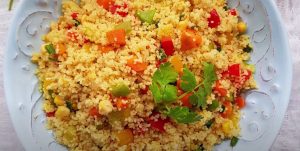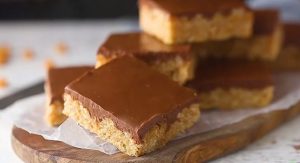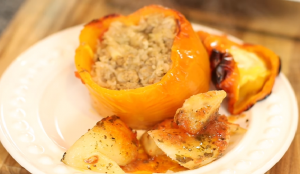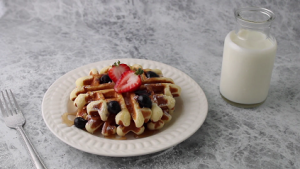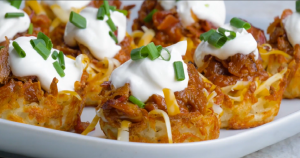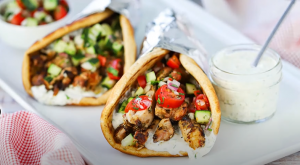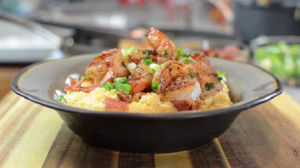This traditional Venezuelan dish, Pork and Chicken Hallacas, is a holiday favorite, often enjoyed during Christmas. It's a flavorful mix of meat stew, corn dough, and vibrant fillings, all wrapped up in a banana leaf for a hearty, satisfying meal.
Some ingredients used in this recipe might not be regular items in your pantry, such as annatto seeds, manzanilla olives, and piloncillo. Annatto seeds are used to infuse the lard with a rich, yellow color and a subtle, earthy flavor. Manzanilla olives are green olives usually stuffed with pimiento, they add a burst of tangy, briny flavor. Piloncillo is unrefined pure cane sugar, shaped in the form of a small cone; it lends a deep, caramel-like sweetness to the stew.
Ingredients for Pork and Chicken Hallacas
Yellow onion: Provides a savory sweetness to the stew.
Scallions: Adds a bright, fresh flavor.
Red bell pepper: Gives a sweet, slightly fruity flavor.
Leek: Enhances the flavor depth of the stew.
Sweet red peppers: Adds a sweet yet mildly spiced flavor.
Lard: Used for sautéing and imparting a rich mouthfeel.
Pork shoulder: The main protein of the stew, it's flavorful and tender.
Tomato: Adds acidity and sweetness to balance the rich flavors.
Worcestershire sauce: Enhances the savory, umami taste of the stew.
Marsala cooking wine: Adds a sweet, complex flavor.
Piloncillo: A pinch adds a hint of sweetness.
Salt: Enhances the individual flavors of the ingredients.
Black pepper: Adds a kick of spice.
Cumin: Gives an earthy, warm flavor.
Tomato paste: Adds intensity and thickness to the stew.
Gelatin packet: Helps thicken the stew.
Annatto seeds: Used to give color and a subtle flavor to the dough.
Red pepper: Adds a slight kick to the corn dough.
Corn flour: Forms the base of the dough.
Chicken stock: Adds flavor to the dough.
Sea salt: Gives the dough its savory taste.
Italian giardiniera: Adds a tangy, pickled flavor.
Dijon mustard: Gives the filling a sharp, tangy flavor.
Chicken: Adds a savory, hearty element to the filling.
Manzanilla olives: Provides a tangy flavor.
Raisin: Gives a sweet contrast to the savory flavors.
Golden raisin: Adds a unique sweetness.
Almonds: Provides a crunchy texture.
One reader, Cynthie Byler says:





The pork and chicken hallacas recipe is a true delight! The combination of flavors is simply divine, and the process of making them is a labor of love. The result is a dish that's bursting with savory and aromatic goodness. I highly recommend trying this recipe for a truly special culinary experience.
Mastering the Techniques for Authentic Hallacas
How to prepare stew: This involves combining and cooking the vegetables, pork shoulder, canned tomatoes, and various seasonings until the meat is fully cooked and shreds easily. The stew is then cooled and refrigerated overnight.
How to prepare dough: This involves cooking annatto seeds with lard, straining the lard, and then mixing it with roasted red peppers, corn flour, and chicken stock. The dough is kneaded until it becomes firm, smooth, and shiny, and then rolled into balls.
How to assemble hallacas: This involves toasting banana leaves, brushing them with annatto-infused lard, placing a ball of dough and spoonful of stew in the center, adding shredded chicken, olives, raisins, almonds, and giardiniera-mustard mixture, folding the hallaca, wrapping it in banana leaves, and tying it with twine before boiling and serving.
How To Make Pork And Chicken Hallacas
Originally from Venezuela, this flavorful pork and chicken hallacas is a tasty corn dough stuffed with savory stew, olives, raisins, Italian giardiniera!
Serves:
Ingredients
For Stew:
- 2cupsyellow onion,chopped
- ½cupscallions,chopped
- 1cupred bell pepper,chopped
- 1cupleek,chopped
- 6small sweet red peppers,stemmed, seeded
- 6tbsplard
- 3lbpork shoulder,diced into ½-inch cubes
- 28oztomato,(1 can) chopped
- ¼cupWorcestershire sauce
- ½cupmarsala cooking wine
- 1piloncillo
- 1tspkosher salt
- ½tspfreshly ground black pepper
- 1tspground cumin
- 2tbsptomato paste
- 2packetsgelatin,unflavored
For Dough:
- ½cuplard
- 1½tbspannatto seeds
- ½cupred pepper,roasted
- 2cupscorn flour,pan flour, pre-cooked
- ¾cupchicken stock
- 1tspfine sea salt
For Assembly:
- ¼cupItalian giardiniera,chopped
- 2tbspdijon mustard
- 1cupchicken,shredded
- 40manzanilla olives
- ½cupraisin
- ½cupgolden raisin
- ½cupalmonds,slivered
Equipments
-
10 banana leaves, thawed if frozen
-
kitchen twine
Instructions
Stew:
-
In a food processor, combine the onion, scallions, red bell pepper, leeks, and sweet red peppers.
-
Pulse until broken down to the consistency of a tapenade.
-
In a large pot over medium heat, add the lard and the pulsed vegetables.
-
Stir to combine and cook for 1 to 2 minutes, until softened slightly.
-
Add the pork shoulder, canned tomatoes, and Worcestershire sauce, and bring to a simmer before adding the marsala, piloncillo, salt, pepper, cumin, tomato paste, and gelatin.
-
Cook for about 4 hours, stirring frequently until the meat is completely cooked and shreds easily.
-
Remove the pot from the heat, allow to cool and refrigerate the stew overnight.
Dough:
-
In a small pot, cook the lard and annatto seeds over high heat until starting to boil.
-
Remove the pot from the heat and let cool.
-
Strain the lard into a bowl and discard the annatto seeds.
-
Set aside 2 tablespoons of the annatto-infused lard for assembly.
-
Add the roasted red peppers to a small food processor and process until liquified.
-
Transfer the puréed peppers to the bowl of a stand mixer fitted with the whisk attachment, along with the corn flour and chicken stock.
-
Mix on medium-low speed until the dough starts to come together.
-
Gradually add the annatto-infused lard and continue kneading.
-
Add the salt and continue kneading until the dough is firm despite its softness, does not stick to the hands, and has a smooth and shiny appearance when rolled into a ball.
-
Roll the dough into 10 balls, each about 2-inches in diameter (about the size of a lemon).
To Assemble:
-
In a small bowl, mix together the giardiniera and dijon mustard.
-
Clean the banana leaves with a damp kitchen towel and remove the vein at the bottom of the leaf, then cut them into 10 sheets about 12×14-inches, 10 middle wrapping sheets, about 12×10-inches, and 10 small sheets or “belts”, about 4×10-inches.
-
Toast the leaves on a flat skillet over low heat for about 30 seconds until they have darkened in color and the leaf is flexible.
-
Brush the center of a 10×12-inch banana leaf with a bit of the reserved annatto-infused lard.
-
Place a ball of dough on the center of the leaf and use a cutting board wrapped in plastic wrap and brushed with more annatto lard to press flat.
-
Place a heaping spoonful of stew in the center.
-
Top with some shredded chicken, 4 olives, a small handful of raisins, golden raisins, and slivered almonds, and 1 teaspoon of the giardiniera-mustard mixture.
-
Carefully fold the hallaca by bringing 2 sides of the leaf together, then folding the sides downward together.
-
Fold in the 2 remaining sides, then turn the hallaca seam-side down.
-
Place the hallaca, folds down, on the top edge of a 12×14-inch banana leaf, then roll down the length of the leaf.
-
Fold in the sides to seal.
-
Place the hallaca, seam-side down, on the short end of a 4×10-inch leaf.
-
Wrap the “belt” around the hallaca, then tie with twine to secure.
-
Repeat with the remaining ingredients.
-
Bring a very large pot of water to a boil over high heat.
-
Once the water is boiling, add the hallacas.
-
Reduce the heat to medium, cover, and cook for 50 to 60 minutes until the banana leaves are muted in color and the filling is fully warmed through.
-
Remove the hallacas from the pot and place them on a wire rack set over a baking sheet.
-
Let cool slightly before serving.
-
The hallacas will keep in the refrigerator for up to 1 month.
-
If serving at a later time, warm the hallacas in boiling water for 15 minutes.
-
Enjoy.
Nutrition
- Calories: 819.81kcal
- Fat: 51.58g
- Saturated Fat: 16.91g
- Trans Fat: 0.01g
- Monounsaturated Fat: 23.81g
- Polyunsaturated Fat: 6.71g
- Carbohydrates: 52.77g
- Fiber: 7.17g
- Sugar: 22.68g
- Protein: 37.94g
- Cholesterol: 124.69mg
- Sodium: 939.77mg
- Calcium: 139.99mg
- Potassium: 1215.82mg
- Iron: 6.31mg
- Vitamin A: 164.48µg
- Vitamin C: 103.77mg
Elevate Your Hallacas with This Simple Technique Tip
When making the dough for your hallacas, it's important to knead it until it's firm yet soft, doesn't stick to your hands, and has a smooth, shiny appearance when rolled into a ball. This texture ensures that the dough will hold up well when filled and cooked. If the dough is too sticky, add a bit more corn flour; if it's too dry, add a bit more chicken stock. Remember, achieving the perfect dough consistency might take a few tries, so don't be discouraged if it's not perfect the first time. Practice makes perfect!
Time-Saving Tips for Making Pork and Chicken Hallacas
Prep ahead: Prepare the stew and dough a day in advance to save time on the day of assembly.
Efficient assembly: Set up an assembly line with all the ingredients and banana leaves ready to streamline the process.
Team effort: Enlist friends or family to help with the assembly process for a fun and efficient cooking experience.
Freeze for later: Make a large batch and freeze the hallacas for future quick and convenient meals.
Organized workspace: Keep your kitchen organized and clean to work efficiently and avoid any unnecessary delays.
Multi-task: While the stew is simmering, work on preparing the dough to maximize your time in the kitchen.
Substitute Ingredients For Pork And Chicken Hallacas Recipe
pork shoulder - Substitute with beef chuck roast: Beef chuck roast has a similar rich and flavorful profile to pork shoulder, making it a great substitute for the stew.
chicken stock - Substitute with vegetable stock: Vegetable stock can add a similar depth of flavor to the dish without the chicken flavor, making it a suitable substitute for the dough.
Presenting Hallacas: Tips for a Beautiful Display
- Elevate the plating: Arrange the hallacas on the plate in an artful and visually appealing manner, ensuring that each element is showcased beautifully.
- Incorporate garnishes: Add a touch of sophistication by garnishing the plate with fresh herbs and edible flowers, enhancing the overall presentation.
- Utilize negative space: Embrace the concept of negative space to allow the hallacas to stand out, creating a visually striking and balanced composition on the plate.
- Employ symmetry: Create a sense of harmony by arranging the hallacas and accompanying elements symmetrically, showcasing precision and attention to detail.
- Highlight vibrant colors: Intensify the visual appeal by incorporating colorful elements such as vibrant bell peppers and raisins, adding a pop of color to the plate.
- Emphasize texture: Showcase a variety of textures, from the tender hallacas to the crunchy almonds, adding depth and complexity to the overall presentation.
- Use elegant serving ware: Select elegant and refined serving ware that complements the dish, elevating the dining experience for the esteemed guests.
Essential Tools for Making Hallacas
- Food processor: A food processor is a versatile kitchen appliance used for chopping, slicing, shredding, pureeing, and mixing a variety of ingredients.
- Large pot: A large pot is essential for cooking stews, soups, and boiling large quantities of food.
- Skillet: A skillet is a flat-bottomed pan used for frying, searing, and browning ingredients.
- Small pot: A small pot is useful for heating and melting ingredients, making sauces, and cooking smaller portions.
- Stand mixer: A stand mixer is a kitchen appliance used for mixing, beating, and kneading dough and batter.
- Cutting board: A cutting board provides a stable surface for cutting, chopping, and preparing ingredients.
- Twine: Twine is used for tying and securing food items, such as trussing meats or securing wrapped packages.
- Wire rack: A wire rack is used for cooling baked goods, draining fried foods, and roasting meats.
- Baking sheet: A baking sheet is a flat, rectangular metal pan used for baking cookies, pastries, and other baked goods.
- Blender: A blender is a kitchen appliance used for blending, pureeing, and emulsifying ingredients to create smooth mixtures.
- Strainer: A strainer is a kitchen tool used for separating liquids from solids or sifting dry ingredients.
- Tongs: Tongs are versatile kitchen utensils used for gripping, lifting, and turning food items while cooking.
- Knife: A knife is an essential kitchen tool used for cutting, slicing, and chopping ingredients.
- Kitchen towel: A kitchen towel is used for drying hands, wiping surfaces, and handling hot cookware.
- Rolling pin: A rolling pin is used for flattening and shaping dough for baking and cooking.
- Measuring cups and spoons: Measuring cups and spoons are used for accurately measuring ingredients in cooking and baking.
- Pot: A pot is a versatile cookware used for boiling, simmering, and stewing ingredients.
- Skewers: Skewers are long, narrow metal or wooden rods used for holding and grilling food items.
- Spatula: A spatula is a kitchen utensil with a broad, flat blade used for lifting, flipping, and spreading ingredients.
- Brush: A brush is used for applying liquids, such as oil or glaze, onto food items or cookware.
- Aluminum foil: Aluminum foil is used for wrapping, covering, and storing food items during cooking and refrigeration.
- Parchment paper: Parchment paper is a non-stick paper used for lining baking sheets and pans to prevent sticking and simplify cleanup.
Preserving the Flavor: Storing and Freezing Hallacas
Here are the detailed storing and freezing guidelines for pork and chicken hallacas:
- Let the cooked hallacas cool completely to room temperature before storing. This prevents condensation from forming inside the wrapping which can make them soggy.
- Wrap each hallaca tightly in plastic wrap or aluminum foil. This helps prevent freezer burn and keeps them fresh longer.
- Place the individually wrapped hallacas in a large freezer bag or airtight container. Squeeze out as much air as possible before sealing to avoid ice crystals forming.
- Label the bag or container with the date so you can keep track of when they were made. Hallacas will keep well in the freezer for up to 6 months.
- To reheat frozen hallacas, there's no need to thaw first. Just place the frozen hallacas directly in a pot of boiling water. Simmer until heated through, about 15-20 minutes. You can test if they're ready by poking the center with a knife - the filling should be piping hot.
- For refrigerator storage, keep the hallacas wrapped and place in an airtight container. They will stay fresh for up to 1 week in the fridge. Reheat refrigerated hallacas the same way as frozen - in a pot of simmering water until warmed through the center.
- To keep the banana leaf wrapping from splitting when reheating, you can wrap each hallaca in a layer of parchment paper or secure the leaves with kitchen twine before placing in the boiling water to reheat.
The Best Methods for Reheating Leftover Hallacas
Here are some methods for reheating leftover pork and chicken hallacas:
Stovetop method: Place the hallacas in a steamer basket over a pot of simmering water. Cover and steam for 15-20 minutes, until heated through. This method helps to retain the moisture and texture of the banana leaves and filling.
Oven method: Preheat your oven to 350°F (175°C). Wrap each hallaca in aluminum foil and place them on a baking sheet. Bake for 20-25 minutes, or until heated through. This method is convenient for reheating larger batches of hallacas at once.
Microwave method (for quick reheating): Remove the string and outer banana leaf wrapping. Place the hallaca on a microwave-safe plate and cover with a damp paper towel. Microwave on high for 2-3 minutes, or until heated through. This method is quick but may result in a slightly softer texture.
Grill method (for a smoky flavor): Preheat your grill to medium heat. Wrap each hallaca in aluminum foil and place them on the grill grates. Close the lid and heat for 15-20 minutes, turning occasionally, until heated through. This method imparts a subtle smoky flavor to the hallacas.
Frying method (for a crispy exterior): Unwrap the hallacas and remove the filling. Heat a tablespoon of vegetable oil in a skillet over medium heat. Fry the hallaca dough until crispy and golden brown on both sides. Serve the crispy hallaca alongside the reheated filling. This method is perfect for those who enjoy a crispy texture.
Discover an Interesting Fact About Hallacas
Hallacas are a traditional Venezuelan dish often enjoyed during the holiday season, particularly at Christmas. They are typically made with a flavorful stew of pork and chicken, wrapped in maize dough, and then encased in banana leaves before being boiled. This process infuses the dish with a unique and aromatic flavor.
Hallacas: An Economical Choice for Home Cooking?
This pork and chicken hallacas recipe is moderately cost-effective for a household. The combination of pork shoulder, chicken, and a variety of vegetables and spices makes it a hearty and flavorful dish. While the initial investment in ingredients may be slightly higher, the recipe yields a large batch, making it suitable for multiple meals. The approximate cost for a household of 4 people is around $40-$50, considering the quantity and quality of ingredients used. Overall Verdict: 8/10.
Are Pork and Chicken Hallacas Healthy or Unhealthy?
The pork and chicken hallacas recipe, while flavorful and traditional, may not be the healthiest option due to several factors:
- High fat content from lard, pork shoulder, and almonds
- Refined carbohydrates in the corn flour dough
- Added sugars from the piloncillo and raisins
- High sodium content from olives, salt, and processed ingredients like Worcestershire sauce and Dijon mustard
However, the recipe does include some nutritious ingredients, such as vegetables (onions, peppers, leeks, and tomatoes) and lean protein from the chicken.
To make this recipe healthier, consider the following modifications:
- Replace some or all of the lard with healthier fat sources like olive oil or avocado oil
- Use lean pork tenderloin instead of pork shoulder to reduce the overall fat content
- Opt for whole grain corn flour to increase the fiber content of the dough
- Reduce the amount of piloncillo and raisins, or replace them with natural sweeteners like dates or honey
- Use low-sodium olives and reduce the amount of added salt
- Incorporate more vegetables into the filling, such as carrots, zucchini, or spinach, to boost the nutrient content
- Serve the hallacas with a side salad or roasted vegetables to balance out the meal
By making these adjustments, you can enjoy the traditional flavors of hallacas while improving the overall nutritional profile of the dish.
An Editor's Take on the Delightful Pork and Chicken Hallacas
This pork and chicken hallacas recipe is a delightful fusion of flavors and textures. The stew is rich and savory, with the pork shoulder adding depth and the marsala wine infusing a subtle sweetness. The dough is vibrant and aromatic, thanks to the annatto seeds and roasted red peppers. The assembly process is a labor of love, resulting in a visually stunning and tantalizing dish. The combination of olives, raisins, and almonds adds bursts of contrasting flavors, making each bite a delightful surprise. Overall, this recipe promises a truly memorable dining experience, showcasing the artistry and complexity of traditional Venezuelan cuisine.
Enhance Your Pork And Chicken Hallacas Recipe with These Unique Side Dishes:
Explore These Delicious Alternatives to Hallacas
Appetizers and Desserts: The Ideal Companions for Hallacas
Why trust this Pork And Chicken Hallacas Recipe:
This recipe offers a traditional and authentic Venezuelan dish, showcasing a blend of flavors and textures. The stew is slow-cooked to perfection, ensuring tender pork and chicken infused with rich, savory spices. The dough is meticulously prepared, incorporating annatto for a vibrant color and subtle earthy notes. The use of banana leaves not only adds an aromatic essence but also preserves the integrity of the dish. With meticulous attention to detail and a focus on quality ingredients such as manzanilla olives, golden raisins, and slivered almonds, this recipe promises an unforgettable culinary experience.
Was this page helpful?
Have your own special recipe to share? Submit Your Recipe Today!



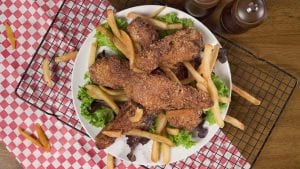

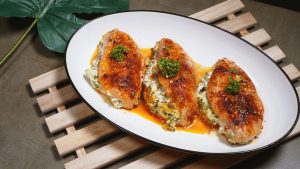
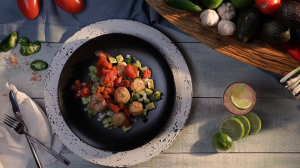
recipe-300x168.png)
